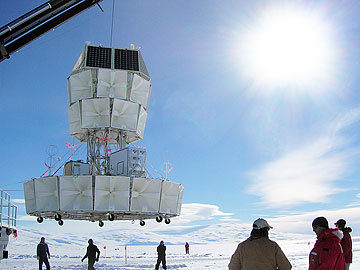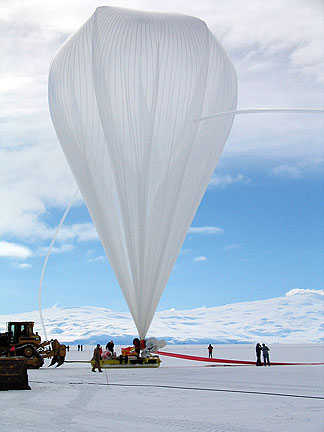
COURTESY OF KIM PALLADINO / OHIO STATE
A neutrino detection machine is shown above in Antarctica. CLICK FOR LARGE
|
|
Scientists seeking neutrinos
A balloon scours Antarctica for particles that could help unlock the universe's origins
A SCIENTIFIC balloon designed to make the first-ever measurements of high-energy neutrinos has completed a 35-day flight over Antarctica, said University of Hawaii professor Peter Gorham, who is leading the project.
As the high-altitude balloon cruised at 120,000 feet above the Antarctic continent, 40 antennas listened for bursts of radio waves like "mini-lightning bolts" from high-energy neutrinos interacting deep within the ice.
"At this point we can't say if we detected any neutrinos," said Gorham, professor of physics and astronomy, explaining that most of the data has yet to be analyzed by the Antarctic Impulsive Transient Antenna team.
Neutrinos are high-energy, invisible elementary particles from cosmic rays detected only by interactions or collisions with matter -- which are rare.
Scientists do not know where neutrinos come from, noting that such a discovery could lead to an understanding of the big-bang theory and the origins of the universe.
"Neutrinos are really at the frontier of our understanding of particle physics, almost mystical in their properties, almost otherworldly. So it's kind of fitting that the last frontier on Earth, Antarctica, turns out to be one of the best places to go and search for them," Gorham said.

COURTESY OF KIM PALLADINO / OHIO STATE
A high-altitude balloon designed to make the first-ever measurements of high-energy neutrinos has successfully completed a 35-day flight over Antarctica. CLICK FOR LARGE
|
|
The team is hoping for "some surprises" in their data, including perhaps a few hundred neutrinos, Gorham said.
"For neutrino physics that's not a bad yield, but our goal was to design the experiment so if we saw no neutrinos at all, that measurement would be an important one," he said. "If fluxes of neutrinos are very low or below our limit of sensitivity ... that begins to be a real problem for our understanding of the highest energy sources in the cosmos."
GORHAM is principal investigator for the project, which involves about 40 scientists, engineers, students, technicians and engineers from eight institutions.
The National Aeronautics and Space Administration provided $8 million for the neutrino observatory.
Antarctica was chosen for the experiment because the ice is transparent to radio waves. "It's quiet ice from a radio point of view," Gorham said.
The balloon was supplied by NASA and launched Dec. 15 from Williams Field about eight miles from McMurdo Station in Antarctica, Gorham said.
The team felt if the balloon was afloat 15 days, it would be a success, and it did not touch down until Jan. 19, just over 35 days, Gorham said. It is the second-longest record for a scientific balloon.
"We're very pleased about that. The sponsors are very happy."
The 4,000-pound instrument payload -- about 18 feet in diameter and 25 feet high -- landed 360 miles from the South Pole near the 7,000- to 8,000-foot elevation on the Antarctica Plateau, he said.
"We designed the (antenna) system so it would be hair-trigger sensitive, so the slightest fluctuation would cause us to make a measurement," Gorham said.
About 9 million events were measured that the scientists called "triggers from the background," when the hiss in the background noise fluctuated enough to make a recording.
"We expect only a few hundred of the 9 million events to be possible neutrinos," Gorham said.
UH has about $400,000, and collaborating institutions also have funds to continue work and make improvements to the detector, he said.
The team will submit a proposal to NASA for two more flights, in December 2008 and December 2010.

